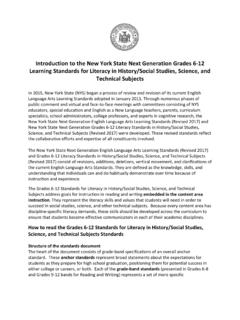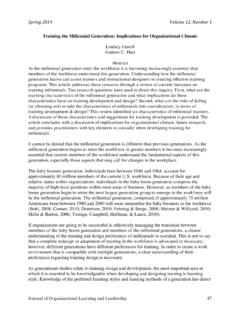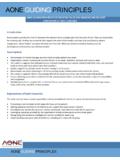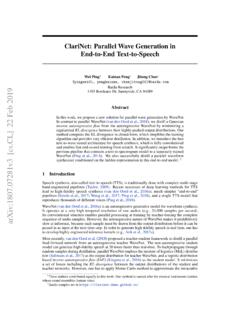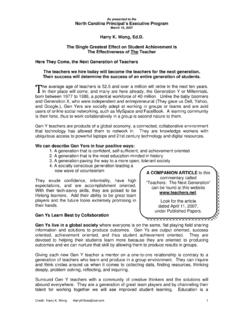Transcription of Machine Learning for Wireless Networks with Artificial ...
1 Machine Learning for Wireless Networks with ArtificialIntelligence: A Tutorial on Neural NetworksMingzhe Chen , Ursula Challita , Walid Saad , Changchuan Yin , and M rouaneDebbah Beijing Laboratory of Advanced Information Network, Beijing University of Posts and Telecommunications,Beijing, China 100876, Email: and School of Informatics, The University of Edinburgh, Edinburgh, UK. Email: Wireless @VT, Bradley Department of Electrical and Computer Engineering, Virginia Tech, Blacksburg, VA,USA, Email: Mathematical and Algorithmic Sciences Lab, Huawei France R & D, Paris, France,Email: Wireless Networks must support ultra-reliable, low-latency communication andintelligently manage a massive number of Internet of Things (IoT) devices in real-time, within a highlydynamic environment. This need for stringent communication quality-of-service (QoS) requirements aswell as mobile edge and core intelligence can only be realized by integrating fundamental notions ofartificial intelligence (AI) and Machine Learning across the Wireless infrastructure and end-user this context, this paper provides a comprehensive tutorial that introduces the main concepts of machinelearning, in general, and artificial neural Networks (ANNs), in particular, and their potential applicationsin Wireless communications.
2 For this purpose, we present a comprehensive overview on a number ofkey types of neural Networks that include feed-forward, recurrent, spiking, and deep neural each type of neural network, we present the basic architecture and training procedure, as well asthe associated challenges and opportunities. Then, we provide an in-depth overview on the variety ofwireless communication problems that can be addressed using ANNs, ranging from communicationusing unmanned aerial vehicles to virtual reality and edge each individual application, wepresent the main motivation for using ANNs along with the associated challenges while also providing adetailed example for a use case scenario and outlining future works that can be addressed using a nutshell, this article constitutes one of the first holistic tutorials on the development of machinelearning techniques tailored to the needs of future Wireless research was supported by the National Science Foundation under Grants CNS-1460316 and [ ] 9 Oct 20172I.
3 INTRODUCTIONThe Wireless networking landscape is undergoing a major revolution. The smartphone-centricnetworks of yesteryears are gradually morphing into a massiveInternet of Things (IoT)ecosys-tem [1] [4] that integrates a heterogeneous mix of Wireless -enabled devices ranging from smart-phones, to drones, connected vehicles, wearables, sensors, and virtual reality apparatus. Thisunprecedented transformation will not only drive an exponential growth in Wireless traffic inthe foreseeable future, but it will also lead to the emergence of new and untested wirelessservice use cases, that substantially differ from conventional multimedia or voice-based instance, beyond the need for high data rates which has been the main driver of thewireless network evolution in the past decade next-generation Wireless Networks must beable to deliver ultra-reliable, low-latency communication [5] [8], that is adaptive, in real-timeto a rich and dynamic IoT environment.
4 For example, drones and connected vehicles [9] [12]will place autonomy at the heart of the IoT. This, in turn, will necessitate the deployment ofultra-reliable Wireless links that can provide real-time, low-latency control for such autonomoussystems. Meanwhile, in tomorrow s Wireless Networks , large volumes of data must be collected,periodically and in real-time, across a massive number of sensing and wearable devices. Suchmassive short-packet transmissions will lead to a substantial traffic over the Wireless uplink, whichhas traditionally been much less congested than the downlink. This same Wireless network mustalso support cloud-based gaming [13], immersive virtual reality services, real-time HD streaming,and conventional multimedia services. This ultimately creates a radically different networkingenvironment whose novel applications and their diverse quality-of-service (QoS) and reliabilityrequirements mandate a fundamental change in the way in which Wireless Networks are modeled,analyzed, designed, and need to cope with this ongoing and rapid evolution of Wireless services has led tomuch research that investigates what the optimal cellular network architecture will be within thecontext of the emerging fifth generation (5G) Wireless Networks ( , see [14] and referencestherein).
5 While the main ingredients for 5G such as dense small cell deployments, millimeterwave (mmWave) communications, and device-to-device (D2D) communications have beenidentified, integrating them into a truly harmonious Wireless system that can meet the IoTchallenges requires instillingintelligent functions across both the edge and core of the intelligent functions must be able to adaptively exploit the Wireless system resourcesand generated data, in order to optimize network operation and guarantee, in real-time, the QoSneeds of emerging Wireless and IoT services. Such mobile edge and core intelligence can only berealized by integrating fundamental notions ofartificial intelligence (AI)[15] across the wirelessinfrastructure and end-user the notion of artificial intelligence can be traced back to the mythological Greek bronzeman Talos [16] an artificially intelligent man- Machine created to protect the island of Crete frominvaders, its true potential has only been recently realized owing to the substantial developmentsinmachine Learning [17], in general, andneural Networks [18], in particular.
6 Indeed, machinelearning tools are undoubtedly the primary vessel that is carrying artificial intelligence to fruitionacross a myriad of applications [19] [26] that range from computer vision to natural languageprocessing, robotics, and autonomous systems. As such, creating AI-enabled Wireless networksis contingent upon developing the right set of Machine Learning and neural network tools thatcan provide the plethora of AI functions needed in future Wireless Networks to unleash the truepotential of the IoT. Such tools must naturally be tailored to the unique features of the wirelessenvironment, which is evidently quite different from the traditional applications of AI, such asin robotics and computer vision [27] [30].For instance, artificial intelligence is expected to play several roles in the next-generationof Wireless Networks [31]. First, the most natural application of AI and Machine Learning is toexploitbig data analyticsto enhance situational awareness and overall network operation.
7 In thiscontext, AI will provide the Wireless network with the ability to parse through massive amountsof data, generated from multiple sources that range from Wireless channel measurements andsensor readings to drones and surveillance images, in order to create a comprehensive operationalmap of the massive number of devices within the network. This map can, in turn, be exploitedto optimize various functions, such as fault monitoring and user tracking, across the , beyond its powerful prediction and data analytics functions, AI will be a major driverof intelligent and data-drivenwireless network optimization. For instance, Machine Learning toolswill enable the introduction of intelligent resource management tools, that can be used to addressa variety of problems ranging from cell association and radio access technology selection tofrequency allocation, spectrum management, power control, and intelligent beamforming.
8 In4contrast to conventional distributed optimization technique, that are often done iteratively inan offline or semi-offline manner, AI-guided resource management mechanisms will be able tooperate in a fully online manner by Learning , in real time, the states of the Wireless environmentand the network s users. Such mechanisms will therefore be able to continuously improve theirown performance over time which, in turn, will enable more intelligent and dynamic networkdecision making. Such intelligent decision making is essential for much of the envisioned IoT and5G services, particularly those that require real-time, low latency operation, such as autonomousdriving, drone guidance, and industrial control. In fact, if properly designed, Machine Learning -based AI optimization algorithms will provide inherentlyself-organizing, self-healing, and self-optimizingsolutions for a broad range of problems within the context of network optimization andresource management.
9 Such AI-driven self-organizing solutions are particularly apropos for ultradense Wireless Networks in which classical centralized and distributed optimization approachescan no longer cope with the scale and heterogeneity of the , beyond its system-level functions, AI can play a key role at thephysical layerof awireless network. As shown in recent works [32] [37], neural Networks and Machine learningtools can be used to redefine the way in which physical layer functions, such as coding andmodulation, are designed and operated, at both transmitter and receiver levels, within a genericcommunication system. Such an AI-driven approach has been shown [32] [37] to have a lotof promise in delivering lower bit error rates and better robustness to the Wireless , but not least, the rapid deployment of highlyuser-centric Wireless services, such asvirtual reality [38] [40], in which the gap between the end-user and the network functions isalmost minimal, strongly motivate the need for Wireless Networks that can track and adapt to theirhuman user behavior.
10 In this regard, Machine Learning is perhaps the only tool that is capableto learn and mimic human behavior, which will help in creating the Wireless network to adaptits functions to its human users, thus creating a truly immersive environment and maximizingthe overall quality-of-experience (QoE) of the , AI-based system operation is no longer a privilege, but rather a necessity for futurewireless Networks . AI-driven Wireless network designs will pave the way towards an unimag-inably rich set of new network functions and Wireless services. For instance, even though 5 Gnetworks may not be fully AI capable, we envision that the subsequent, sixth generation (6G)5of Wireless cellular Networks will be almost completely reliant on AI and Machine Learning ,as evidenced by recent developments of AI-enabled mobile Networks proposed by Huawei [41]and big innovation house" proposed by Qualcomm [42].


![arXiv:0706.3639v1 [cs.AI] 25 Jun 2007](/cache/preview/4/1/3/9/3/1/4/b/thumb-4139314b93ef86b7b4c2d05ebcc88e46.jpg)
![arXiv:1301.3781v3 [cs.CL] 7 Sep 2013](/cache/preview/4/d/5/0/4/3/4/0/thumb-4d504340120163c0bdf3f4678d8d217f.jpg)
![@google.com arXiv:1609.03499v2 [cs.SD] 19 Sep 2016](/cache/preview/c/3/4/9/4/6/9/b/thumb-c349469b499107d21e221f2ac908f8b2.jpg)





